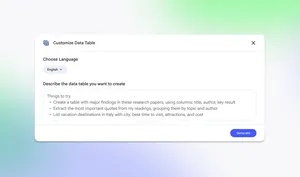Try ImageFX and MusicFX, our newest generative AI tools in Labs
Today we’re releasing ImageFX, a new image-generation tool powered by Imagen 2, Google DeepMind’s latest text-to-image model that delivers our highest-quality images yet. ImageFX offers users a powerful interface to quickly and safely explore image generation. We've also improved our existing generative AI creation tools MusicFX and TextFX.
A new way to create images with ImageFX
ImageFX is a new tool in Labs that lets people create images with simple text prompts. Our early experiments in Labs highlighted how important creative exploration is to new users of generative AI tools. People often discover new ideas through testing a range of prompts and concepts as they iterate. To spur further creativity, ImageFX includes a prompt interface featuring “expressive chips” that let you quickly experiment with adjacent dimensions of your creation and ideas.
A sped up illustrative example of using ImageFX to generate images and explore ideas with “expressive chips,” featuring an example of a hand drawn portrait.
Improvements to MusicFX, our generative AI text-to-music experiment
With MusicFX, our generative AI text-to-music experiment released last year, people can now create tunes up to 70 seconds in length and music loops, explore prompts with expressive chips, and download or share their creations with friends.
Since launch, people have used the tool to create more than 10 million tracks. With feedback and improvements to our underlying MusicLM model, we’re enabling new capabilities like higher-quality audio and faster music generation. In early testing, the music samples generated with these new updates are now preferred three times more than previous ones.
Illustrative example of expressive chip explorations within MusicFX

Inspired writing with TextFX
Last year, we collaborated with Lupe Fiasco to develop TextFX, a generative AI experiment for lyricists, wordsmiths, and everyone in between to explore creative possibilities with text and language. Since launch, we’ve been inspired by how people have used TextFX to empower their writing. We've recently implemented usability updates to improve the overall user experience and navigation.
Illustrative example of writing explorations within TextFX
Safely exploring generative AI with Google
Today’s launches extend our commitment to developing technologies responsibly, in alignment with Google’s AI Principles. With the increased ability to generate photorealistic images with Imagen 2, we’ve made significant investments in training data safety and added technical guardrails to limit problematic outputs like violent, offensive, or sexually explicit content as well as applying filters to reduce the risk of generating images of named individuals. We also conduct extensive adversarial testing to identify and mitigate potential harmful and problematic content.
All images generated with ImageFX and all songs produced using MusicFX are marked by SynthID, a tool developed by Google DeepMind that adds a digital watermark directly into the content we generate. SynthID watermarks are imperceptible to the human eye and ear, but detectable for identification. In addition, all images generated using ImageFX include IPTC metadata, giving people more information whenever they encounter our AI-generated images. We’ll continue investing in these and other techniques to improve the safety and privacy protections of our models.
These tools are available in the U.S., New Zealand, Kenya, and Australia. Visit labs.google to try these experiments and more.







